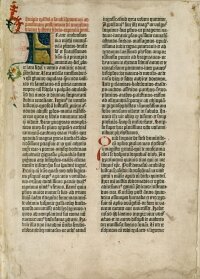 An epistle (pronounced [ɪˈpɪsəl]) (Greek επιστολη, epistolē, 'letter') is a writing directed or sent to a person or group of people, usually a letter and a very formal, often didactic and elegant one. The epistle genre of letter-writing was common in ancient Egypt as part of the scribal-school writing curriculum. The letters in the New Testament from Apostles to Christians are usually referred to as epistles. Those traditionally attributed to Paul of Tarsus are known as Pauline epistles and the others as 'catholic' or general epistles.
An epistle (pronounced [ɪˈpɪsəl]) (Greek επιστολη, epistolē, 'letter') is a writing directed or sent to a person or group of people, usually a letter and a very formal, often didactic and elegant one. The epistle genre of letter-writing was common in ancient Egypt as part of the scribal-school writing curriculum. The letters in the New Testament from Apostles to Christians are usually referred to as epistles. Those traditionally attributed to Paul of Tarsus are known as Pauline epistles and the others as 'catholic' or general epistles.The ancient Egyptians wrote epistles, most often for pedagogical reasons. Egyptologist Edward Wente (1990) speculates that the Fifth-dynasty Pharaoh Djedkare Isesi—in his many letters sent to his viziers—was a pioneer in the epistolary genre. It's existence is firmly attested during the Sixth Dynasty of the Old Kingdom, and is prominently featured in the educational guide The Book of Kemit written during the Eleventh Dynasty. A standardized formulae for epistolary compositions existed by the time of the Middle Kingdom of Egypt. The epistolary formulae used in the Ramesside Period found its roots in the letters composed during the Amarna Period of the Eighteenth Dynasty. Wente describes the "Satirical Letter" found on the Papyrus Anastasi I of the Nineteenth Dynasty as an epistle which was commonly copied as a writing exercise by Egyptian schoolchildren on ceramic ostraca (over eighty examples of which have been found so far by archaeologists). Epistle letters were also written to the dead, and, by the Ramesside Period, to the gods; the latter became even more widespread during the eras of Persian and Greek domination.
More...


No comments:
Post a Comment